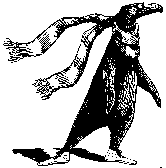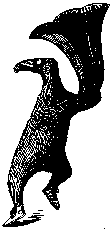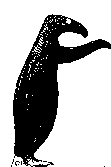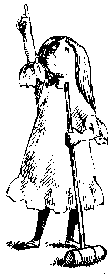EDWARD GOREY: |
This article was first published in American Book Collector, May 1971, Vol. 21, No. 7
Edward Gorey is an artist whose volumes of drawings amuse, delight and provoke a small coterie of collectors. His distinctive and characteristic style of drawing is joined with a mordant wit and a taste for the outre. There is also enough mystery or obscurity in his stories to challenge the viewer-reader to answer the question "What does he mean?" As is true of most artists, his work is not all of a piece and his style of drawing may vary from book to book, and his writing may move from the relative explicit to the obscure. Since his first work published in 1953, Gorey has published twenty-nine very small albums each containing about thirty drawings. Some of these works consist only of the drawings, with or without titles. Others have what might, by some stretch of the imagination, be called a story line and others illustrate a limerick or verse. There is, however, a special logic in the text and the reader should not expect a natural progression of meaning in viewing the drawings. Gorey's world is inhabited by characters out of Bronte, Wodehouse or a three volume Gothic novel. Upper class men are clothed in the Edwardian styles of peg top trouser, striped blazers, boaters, ankle length furred collared coats and knee length scarves, while the females, depending on age, appear in middie blouses or floor length skirts, shirt waist with puffed sleeves, feather boas, vast picture hats and parasols. His servants know their places below stairs and the lines between all classes are clearly defined. Gorey's work expresses words more than ideas and a feeling of menace is rarely absent. We have an expectation of unspeakable horror which is never realized. In The West Wing most of the drawings are of empty or nearly empty rooms, dark, paneled and ominous. The settings create a mood of uneasiness but violence, even when it occurs, is usually offstage. In The Doubtful Guest a Victorian household is invaded by a penguin-like creature in tennis shoes. The family, unable to cope with this inexplicable problem, suffers its presence and it remains a burden to all and an enigma to the end. This note of irresolution or persistence of discomfit occurs in several tales. A similar invasion of a strange being occurs in The Sinking Spell but there the apparition eventually departs. The Hapless Child might well be the daydream of an unhappy child who uses her own death to act out revenge on her parents. A bland, vapid, innocent child is punished wrongly by her teachers, her doll is torn apart by other children, she weeps alone in bed, is kidnapped by a "low" man and when finally cast adrift, with fading eyesight, is run over and killed by her own father who does not recognize her. This defeat of the innocent recurs in Gorey's work; virtue or good never triumph and disaster is as unpredictable as an earthquake. Not all Gorey's work is solemn. The Curious Sofa is a jolly salacious work full of invention and humor. The Gilded Bat is an expression of Gorey's interest in ballet, and The Utter Zoo and The Fatal Lozenge are alphabet books for grown-up children. In content the Gorey landscape is full of balustrades, giant urns, statues and bleak prospects. His interiors are built rather than drawn with great detail of moulding, cornice, cupboard and doors. His wallpaper is involved and dark, curtains are fringed, roped and knotted, furniture massive. All of his characters but one have empty vacant faces; the exception is a tall bearded male, often seen in a quilted robe or driving duster who dominates those about him. His characters bear suggestive names: Mrs. Umlaut, Miss Skrimpshaw, Maudie Splaytoe, Miss Underfold, Luke Touchpaper. They live in places like West Elbow, Penetralia or Hiccupboro. Gorey's puckish humor extends to the pseudonyms he used in some of his works. Ogdred Weary and (Mrs.) Regera Dowdy are two of his nom de plumes, being anagrams of his own name. In addition to the twenty-nine albums in which Gorey has supplied both drawings and text (when there is a text), he has also illustrated a great number of other books, mostly children's books along with a few adult classics. In the main he carefully considers his oeuvre the books in which he is the sole artist. All of the work he does for others, he accepts reluctantly, as the price an artist pays to be able to do the few things which represent his own art. His very distinctive style makes him a natural for children's books, but he also draws book jackets, covers, and other types of commercial illustrating. With one important exception, nothing has been written about Gorey's work. In 1959 Edmund Wilson wrote a short but perceptive review of Gorey's first four books for The New Yorker. In this he likens Gorey's work to that of Ronald Searle and Max Ernst; he also equates him with Beardsley and Beerbohm, high praise indeed. Wilson takes some pains to describe the story line of these works and notes the persistence of the unresolved conflicts which Gorey creates. Of Gorey's verse he has some mild reservations, but of the drawings he is unreserved -- "he is really becoming a master." Gorey was born in Chicago, and graduated from Harvard in the class of 1950, having majored in French. Like many natural born artists, he has drawn all his life and his earliest work is found in school publications. For a very brief period he was employed in the art department of a publishing house, but he quickly returned to the life of the freelance artist. His studio in mid-town Manhattan within walking distance of his many clients, is shared with three cats and thousands of books. He is a music and ballet enthusiast and an avid reader of murder, both fictional and true. Because Gorey's audience will always be small (most of his books have been limited to a few hundred copies) there is the danger that this limitation can be self-imposed. His early works are already relatively scarce, and there is the temptation to cater to the expensive limited edition which his growing body of collectors might support. So far this has not happened, and the scarcity of even his more recent albums, despite the smallness of his coterie, may be due to the difficulty of classifying his work which makes distribution difficult. A number of his albums are published under his own imprint, The Fantod Press, due no doubt to this very problem of how his work is to be categorized. In addition about a dozen regular publishers have handled his work and this dispersal does not help to keep his work in print. Like many an artist, Gorey is concerned with the direction of his future work. His highly original and striking style and the imaginative settings and characters with which he has peopled them are a high mark to transcend or even to equal. He is anxious not to repeat himself. An admirer of Saul Steinberg, whose inventiveness seems to know no bounds, he has tried many different techniques, reflecting both the mood, subject and style of his current work. A few of his own drawings, as cartoons, have appeared in The New York Times. It is a field in which he could display his considerable talents, his sense of the macabre, the question of identity and the air of aimless chance are all in tune with the times. We may see more of his work in a wider medium. |

|
|

|
|

|
|

|
|